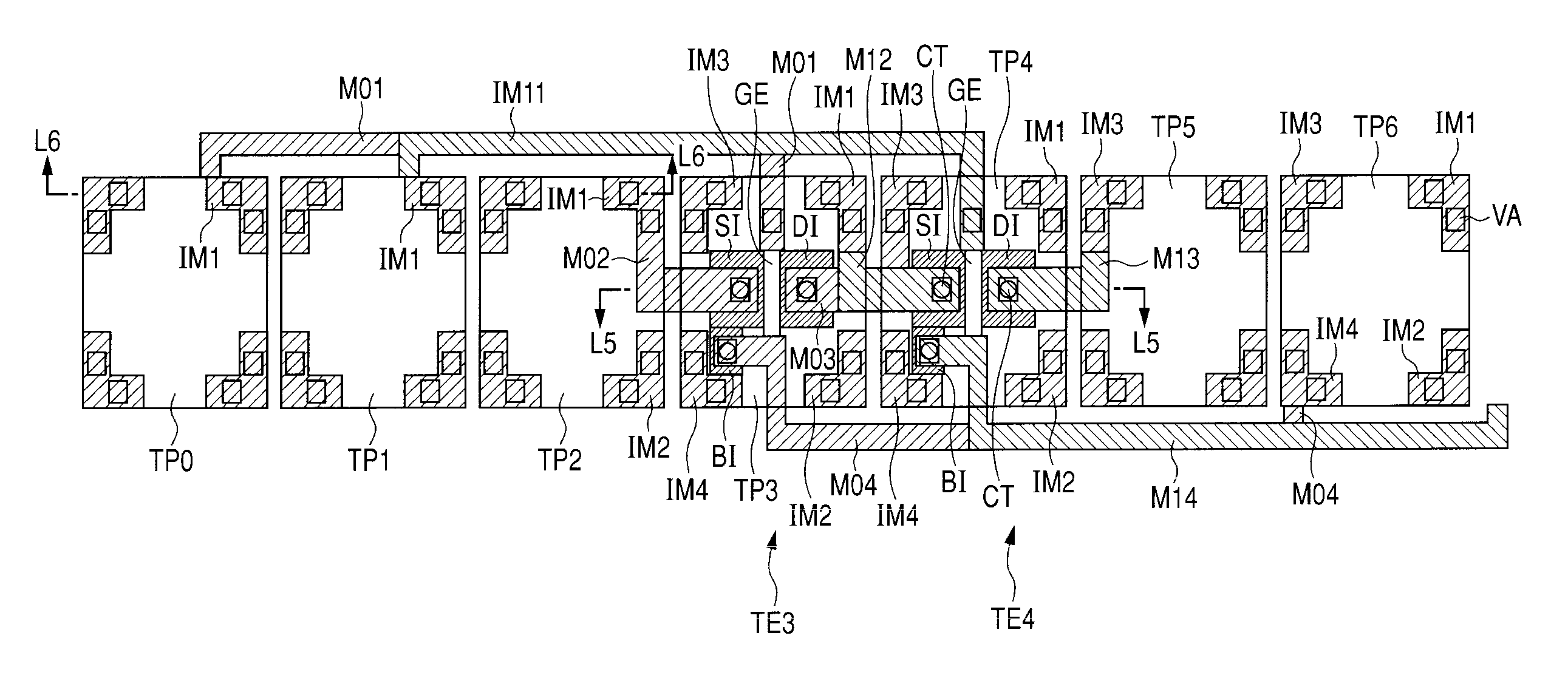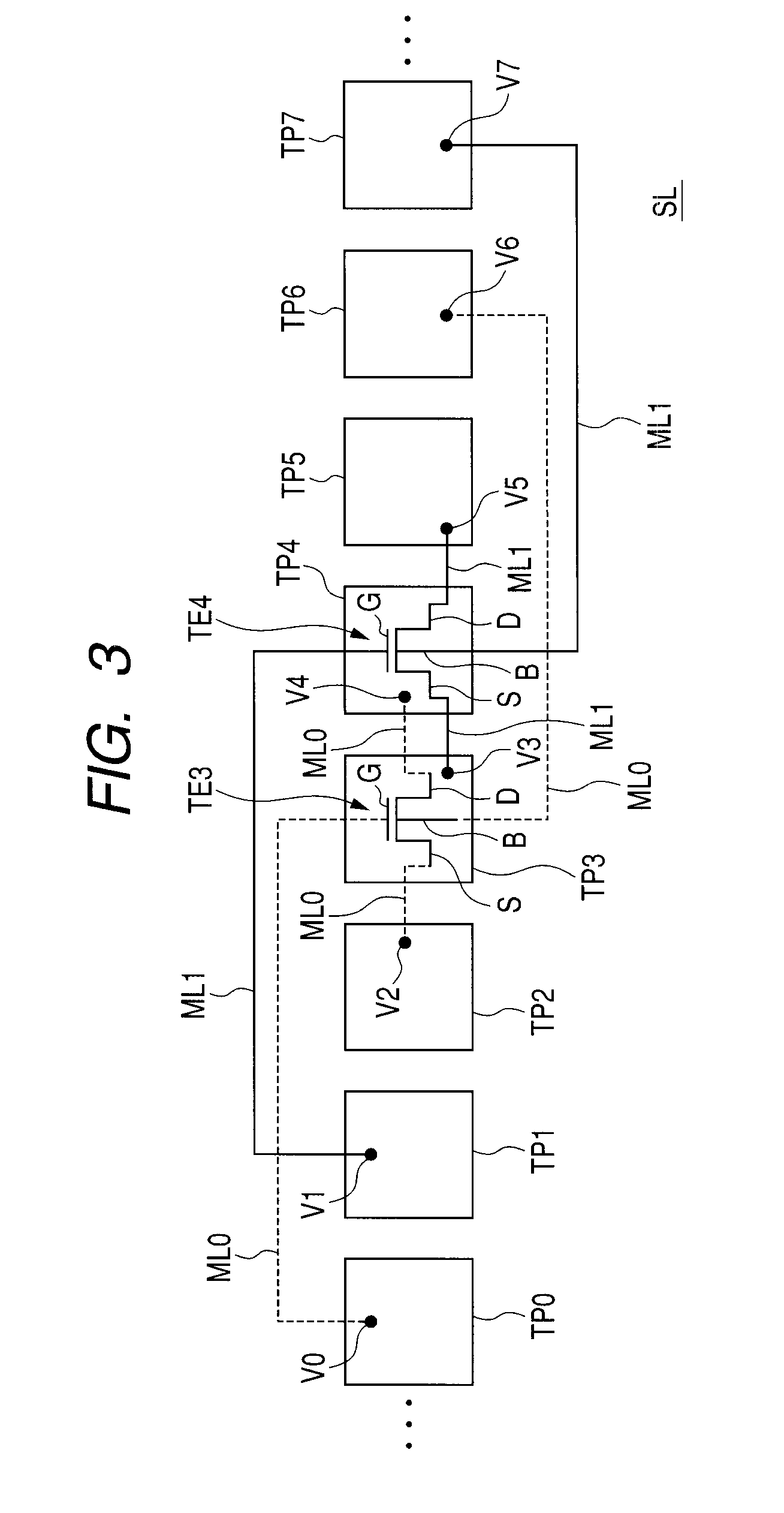Manufacturing method of a semiconductor device, a semiconductor wafer, and a test method
a manufacturing method and semiconductor technology, applied in semiconductor/solid-state device testing/measurement, semiconductor/solid-state device details, instruments, etc., can solve the problem of difficult contact between test probe pins and corresponding test electrode pads, severe pitch condition, and inability to narrow the width of each scribe line, etc. problem, to achieve the effect of reducing the number of elements/members in the scribe area, and reducing the number of scribe lines
- Summary
- Abstract
- Description
- Claims
- Application Information
AI Technical Summary
Benefits of technology
Problems solved by technology
Method used
Image
Examples
first preferred embodiment
[0062]FIG. 1 is a diagram schematically showing a chip layout of a semiconductor wafer WF according to a first preferred embodiment of the present invention. In FIG. 1, a plurality of semiconductor chips CH are arranged over the semiconductor wafer WF in array form. Target semiconductor circuit devices are formed over these semiconductor chips CH. Scribe lines SL are formed to separate these semiconductor chips CH individually and mount or implement them in a package. After a wafer test process has been completed, the semiconductor chips CH formed over the semiconductor wafer WF are individually separated from one another by performing their dicing along the scribe lines SL. As will be described in detail later, test elements and test electrode pads that configure each TEG are placed in alignment in a signal row within areas with the scribe lines SL formed therein.
[0063]FIG. 2 is a diagram showing, in enlarged form, a broken-line area I lying over the semiconductor wafer WF shown in...
second preferred embodiment
[0124]FIG. 14 is a diagram schematically showing a plan layout of a TEG according to a second preferred embodiment of the present invention. In FIG. 14, test electrode pads TPa through TPd are disposed in alignment in one row. Resistive elements R1 and R2 are formed in their corresponding areas lying directly below the test electrode pads TPb and TPc as test elements TE. The resistive element R1 is comprised of a first-layer metal wiring and the resistive element R2 is comprised of a second-layer metal wiring. The resistive element R1 is electrically coupled to the test electrode pads TPa and TPc adjacent thereto, and the resistive element R2 is electrically coupled to the test electrode pads TPb and TPd adjacent thereto. In a manner similar to the first preferred embodiment even in the configuration of the TEG shown in FIG. 14, island-like metal portions are provided corresponding to the test electrode pads for electrical couplings between the test electrode pads and the test eleme...
third preferred embodiment
[0150]FIG. 24 is a diagram schematically showing a plan layout of a TEG according to a third preferred embodiment of the present invention. In FIG. 24, test electrode pads TPa through TPd are placed in alignment in a single row in a manner similar to the second preferred embodiment. Capacitive elements CP1 and CP2 are respectively placed in areas lying directly below the test electrode pads TPb and TPc as a TEG. The capacitive element CP1 has electrode wirings PL1 and PL2 having comb's tooth portions. These comb's tooth portions are disposed so as to engage with each other. The electrode wirings PL1 and PL2 are respectively configured of a first-layer metal wiring and electrically coupled to the test electrode pads TPa and TPc.
[0151]The capacitive element CP2 has electrode wirings PL3 and PL4 each formed of a second layer wiring and has comb's tooth portions disposed opposite to each other in a manner similar to the above capacitive element.
[0152]These capacitive elements CP1 and CP...
PUM
| Property | Measurement | Unit |
|---|---|---|
| electrically coupling | aaaaa | aaaaa |
| areas | aaaaa | aaaaa |
| electrically | aaaaa | aaaaa |
Abstract
Description
Claims
Application Information
 Login to View More
Login to View More - R&D
- Intellectual Property
- Life Sciences
- Materials
- Tech Scout
- Unparalleled Data Quality
- Higher Quality Content
- 60% Fewer Hallucinations
Browse by: Latest US Patents, China's latest patents, Technical Efficacy Thesaurus, Application Domain, Technology Topic, Popular Technical Reports.
© 2025 PatSnap. All rights reserved.Legal|Privacy policy|Modern Slavery Act Transparency Statement|Sitemap|About US| Contact US: help@patsnap.com



